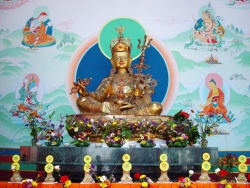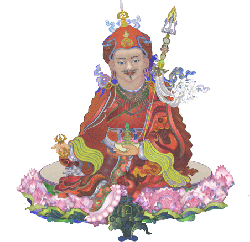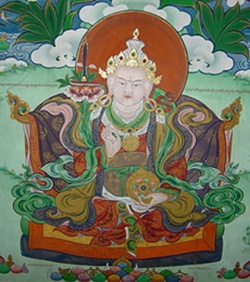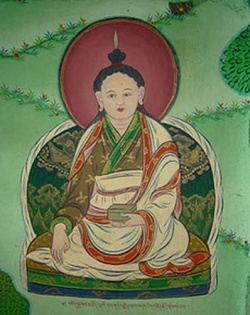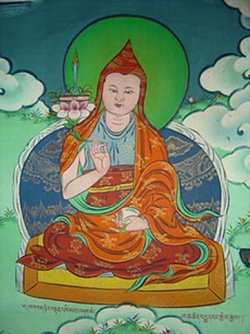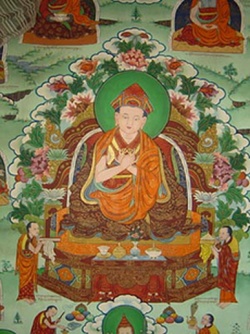History of the Northern Treasures Nyingma Lineage
In the 8th century, the influence of the Kingdom of Tibet extended from what is now China and Iran to the Ganges River in India. Tibet was the military power of central Asia.
Buddhist teachers had been coming to Tibet for some time but their influence had been limited. According to tradition, the Khenpo Shantarakshita had been teaching there for some time but was unable to establish anything permanently. He advised the king to invite Padmasambhava, an adept in the branch of Buddhism known as Mantrayana or Tantrayana.
The work of Padmasambhava, Shantarakshita and King Trisong Detsen (790-858 CE) can easily be found elsewhere. Together they established Buddhism in Tibet setting the stage for the next twelve hundred years of Tibetan culture and life.
Before leaving Tibet, Padmasambhava was requested by his Nepali consort Shakya Devi to leave teachings for future generations. With the help of Lady Yeshe Tsogyal, Padmasambhava hid teachings in various places. Known as treasures (Tib. gter), they were intended to inspire future generations by providing both methods of meditation practice which are fresh and objects of support to inspire and deepen practice.
Padmasambhava
Padmasambhava
Treasures as objects can include ritual implements, statues, paintings. Others are teachings found written on scrolls of yellow parchment written in a script which can only be comprehended by the one intended by Padmasambhava to receive it.
The revealers of these treasures are subsequent rebirths of the disciples of Padmasambhava. There are other teachings which might be treasures of other masters, but among the Buddhist schools in Tibet, the treasure traditions are almost exclusively attributed to Padmasambhava’s intention.
Among the many great disciples of Padmasambhava who later appeared in the Northern Treasure lineage are: Nanam Dorje Dudjom, Namkhai Nyingpo, Nyag Jnanakumara, Gyalwa Choyang, and Princess Pemasal.
Nanam Dorje Dudjom was one of the messengers King Trisong Detsen had sent to India to invite Padmasambhava to Tibet. Upon his return from this trip, he became one of the King’s close advisors and ministers as well as one of Padmasambhava’s closest disciples. Practicing the sadhana of Vajrakilaya, his awakening was so complete that he could easily pass through solid rocks and transport himself from place to place instantly.
Padmasambhava gave many teachings to his disciples throughout his time in Tibet. The teachings received and destined to be discovered by Nanam Dorje Dudjom’s future incarnation Rigdzin Godem were predicted to be important for future descendants of the King Trisong Detsen.
In addition, the teachings themselves contain many prophecies which explain their importance to the well being of Tibet as a place of religious practice. They also contain many statements by Padmasambhava that the continuation of the Northern Treasures is vital to the well being of Buddhism itself.
Rigdzin Godem
Rigdzin Godem or Ngodrup Gyeltsen was born February 11, 1337 C.E. to a noble family just north east of Mt. Tratzang in the western Tibetan province of Tsang. His father’s family had estates given by Trisong Desten’s father to their ancestor for accompanying the king’s Chinese bride, the Princess Chin-ch’eng, to Tibet and for later serving as a minister for religious affairs.
The young Ngodrup Gyeltsen learned the practice of Vajrakilaya from his father as well as other practices such as Matara and Mayajala. At the age of twelve, three vulture feathers, or perhaps three tuffs of hair which looked like vulture feathers, grew from his head. At the age of twenty-four, five more appeared. After this, he was known as Rigdzin Godemcen (Tib: rGod kyi lDem-’phru-can) “the one with vulture feathers.” He was also given the titles Rigdzin Chenpo (Tib.) or Mahavidyadhara (Skt.), the Great Holder of Awareness.
At this time there was another incarnate lama, Tulku Zangpo Drakpa living in central Tibet. Zangpo Drakpa was a follower of the Kagyu school born in Latod (La sTod). Zangpo Drakpa was the rebirth of King Trisong Desten’s son Mune Tsepo. Spending many years in retreat, Zangpo Drakpa was disturbed one morning by the appearance of a young man who urged him to leave his retreat in order to reveal certain treasures.
Zangpo Drakpa dismissed this as just some meditation disturbance. In fact, this was no ordinary boy but the protector of the region of Gondu. He urged Zangpo Drakpa to find the treasures intended for him. Some days later Zangpo Drakpa decided to visit a nearby village. In route, he saw an old, dirty yogi sitting by the roadside who began to mock him, finally challenging Zangpo Drakpa to a debate about Buddhist teaching. Zangpo Drakpa agreed and found that this grungy vagrant could match him point by point.
Thinking that he should make a connection with him despite his appearance, Zangpo Drakpa searched in his bag for a white scarf to offer. As he looked up, in place of a beggar was Padmasambhava himself. As Zangpo Drakpa prostrated, Guru Padma spoke to him: “Zangpo Drakpa, I sent the protectors and you didn’t listen. Finally, I had to come here myself. This is your time. Please go and find these teachings!” Padmasambhava gave a list of teachings he was to bring forth as well as the explanations for them.
Ngari Panchen Pema Wangyal
Subsequently, Zangpo Drakpa revealed over fifty-five scrolls of teachings. Among these was The Prayer in Seven Chapters. He realized that this text was intended for someone else. Accordingly, in the first month of the snake year (1365 C.E.) he gave the scrolls to three of his disciples. They were instructed to travel east of Zang Zang mountains.
Zangpo Drakpa told them that they would encounter a yogi who would be carrying either a rosary or a statue of Vajrakilaya. He would also be talking from the outset of their meeting about the king of Gunthang and the state of affairs in Tibet.
On the eighth day of their journey, the three companions were sharing a meal by a stream at the end of the Daglung Monastery. A man came up carrying a rosary and a statue of Vajrakilaya whom they invited to eat with them. He accepted and having sat down, immediately began to decry the state of Tibet and bemoan the welfare of the royal house in Gungthang. The companions immediately gave the stranger the scrolls and a letter from Zangpo Drakpa. Thus Rigdzin Godem came in possession of a list of treasures and the key to opening them. The key is known to us as Leu Deunma, or the Prayer in Seven Chapters.
These prayers have remained popular throughout Tibet. Currently available in several translations into English, the practices based on each chapter were later revealed by Ngari Panchen Pema Wangyal as treasures. Jamgon Kongtrul also wrote a set of visualizations according to the Mindrolling tradition.
In the year 1366 C.E. (the Fire Horse year of the Tibetan calendar), on April 19th (eighth day of the snake month) Rigdzin Godem brought out the key to the main body of the Northern Treasures from the top of mount Tratzang.
On June 14th (fourth day of the sheep month), he brought out the treasures themselves. Waiting with his disciples, the first rays of sunlight struck inside a cave on a rock shaped like a crossed vajra. Under this, he found a rock door which opened to the chamber containing a square blue chest with five compartments. Each compartment held teachings which over time, he transcribed, practiced and in due time transmitted. Since each section contained teachings on one hundred topics, there were five hundred in all along with various sacred objects.
Rigdzin Pema Trinley
Later in life, Rigdzin Godem traveled to Sikkim where he taught Dharma, opening several monasteries. There in the year 1408, he dissolved into the Dharmakaya at the age of seventy-two at Zilnon Lhakang. Among his disciples were those known as the eight close sons, the eight consorts, and the three close disciples.
His son Namgyel Gompo, his student Gompo Dorje, and his consort were his main students. From these, flowed out three streams of teachings and practice until the time of the fourth Rigdzin Godem tulku, Pema Trinley who united these into one stream of practice.
Just as a minister serves the needs of the king and kingdom, these teachings are known as serving the needs of people throughout the land. Dilgo Khyentse used to say that the Northern Treasures is like a minister since it contains teachings from the more esoteric to the mundane. The minister has the capacity to reach everyone, to relate to people at all levels; he has to be able to relate to people at the highest level, such as a king, and he also has to be able to relate to ordinary people. The Northern Treasures was one of the main practices of King Trisong Detsen. Later it became the main practice of the great Fifth Dalai Lama.
The main seat of the Northern Treasures teaching was the great monastery of Thubten Dorje Drak, one of the six great Nyingma monasteries. There’s a quote from Guru Rinpoche that says, ‘When this excellent teaching degenerates, then Tibet in general will degenerate.’ All the different teachers have said that the Northern Treasures was particularly created as a means to preserve the happiness and well being of the people of Tibet. Since the Northern Treasures has been established and practised in Tibet, almost all Nyingma teachers have practised this tradition.
This collection contains the extensive practice of the Eight Heruka Sadhanas, the Rigdzin Dungdrub, the sadhana of the Lineage of Vidyadharas, the instructions on Guru Dragpotsal, the Wrathful Guru, the instructions on Drowa Kundrol, Avaloketisvara, Tamdrin Dregpa Kundul, the practice of Hayagriva, the unique Northern Treasures Kilaya, a particularly powerful form of Vajrakilaya, and the Dzogchen Kadak Rangjung Rangshar, Self-Existing and Self-Manifest Primordial Purity.
At the core of the Northern Treasures is the profound Gongpa Zangthal, Showing Directly The Realization of Samantabhadra, the primordial buddha. This is the Dzogchen, the ultimate and highest teaching of the Nyingma tradition, passed from one qualified Northern Treasures master to another. Renowned for its profundity and clarity, it has been the source of realization for many practitioners over the centuries.
Other renowned practices, familiar to many, such as the ‘Aspiration of Samantabhadra,’ come from the Northern Treasures tradition.
